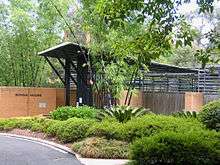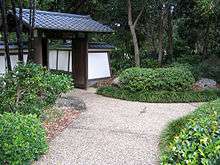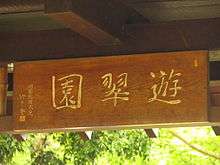Brisbane Botanic Gardens, Mount Coot-tha
| Brisbane Botanic Gardens | |
|---|---|
|
Tropical Display Dome of the Botanical Garden | |
| Type | Botanical |
| Location | Toowong, Queensland |
| Area | 52 hectares (130 acres) |
| Opened | 1970 |
| Owned by | Brisbane City Council |
| Collections | 27°28′35″S 152°58′34″E / 27.4765°S 152.9761°ECoordinates: 27°28′35″S 152°58′34″E / 27.4765°S 152.9761°E |

The Brisbane Botanic Gardens (formerly the Mount Coot-tha Botanic Gardens) are located 7 kilometres (4.3 mi) from the Brisbane CBD in Toowong, Queensland, Australia, at the foot of Brisbane's tallest mountain, Mount Coot-tha.
History
The gardens, which were originally called the Mount Coot-tha Botanic Gardens and which cover 52 hectares, were established by the Brisbane City Council in 1970, and officially opened in 1976.[1] The gardens are the second botanical gardens established in Brisbane. The original gardens, now known as the City Botanic Gardens are located in the Brisbane CBD at Gardens Point. The new gardens were developed by the City Council because the original city site could not be expanded and was flood prone.
Features
Features of the Brisbane Botanic Gardens include:
- Tropical Display Dome—opened in December 1977, 28 m in diameter and 9 m high[1]
- Japanese Garden
- Bonsai House
- Fern House
- Arid Zone and Cactus House
- Exotic Rainforest
- Australian Rainforest
- Fragant Plant and Herb Garden
- Temperate Garden
- Lagoon and Bamboo Grove
- Australian Plant communities
- National Freedom Wall
The gardens are open every day of the year from 8am to 5pm. Entry to the gardens is free.

Sir Thomas Brisbane Planetarium
Located adjacent to the entrance of the gardens is the Sir Thomas Brisbane Planetarium, which incorporates the Cosmic Skydome. Sir Thomas Brisbane, in addition to being the Governor of New South Wales after whom the city of Brisbane was named, was also a renowned astronomer who catalogued the southern skies of Australia during his term.
Japanese Garden


Designed by one of Japan's leading traditional Japanese garden proponents the late Kenzo Ogata (his last work), the garden is faithful to Japanese Garden design concepts, and uses Australian trees, native shrubs and flowers.
The Japan Pond and Garden was re-located from the Japanese Government Pavilion at Brisbane's World Expo '88, and was opened after the conclusion of the Expo on 6 February 1989 through the work of the Brisbane Lord Mayor Sallyanne Atkinson and Nichahiro Hanamura, the chair of the Japan Association for the Expo. A commemorative dedication plaque from Brisbane City Council and the Japan Association for the 1988 Leisure Exposition and a welcome gate with calligraphy on a dedication tablet above the gate by then Prime Minister of Japan Noboru Takeshita greets visitors to the Garden at the entrance to the Garden. The Japanese calligraphy is engraved in gold, dedicating the name of the garden "yu-tsui-en". This literally translates to "enjoy, blue-green, garden" and simply means "Come in to this garden and enjoy the blue of the water and green of the trees".
The theme of the garden ‘tsuki-yama-chisen’ or ‘mountain-pond-stream’ is reflected in the water feature of the garden. Another feature which is not to be forgotten is just as special as the previous; the stone ‘tsukabai’ or water bowl. It is more than 100 years old and is used to "provide running water needed in the purification ritual that occurs before the tea ceremony". The most captivating feature of the garden is the stones which create the mountain. These stones of the waterfall suggest "endurance and the eternal passing of time".
In 2005 a clump of bamboo flowered just outside the gates to the Japanese Garden. Bamboo flowering is very rare and many bamboo enthusiasts go their whole lives without ever witnessing such an event. As is often the case after bamboo flowers, this plant died and was replaced with another specimen.
An annual Japan Cultural Festival is held at the Garden in September, featuring Japanese tea ceremony, Japanese calligraphy and ikebana flower displays.

See also
References
External links
| Wikimedia Commons has media related to Brisbane Botanic Gardens at Mount Coot-tha. |
- Brisbane Botanic Gardens Mount Coot-tha
- Sir Thomas Brisbane Planetarium - Sir Thomas Brisbane Planetarium
